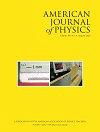耦合摆水平吸引的实验证明
IF 0.9
4区 教育学
Q3 EDUCATION, SCIENTIFIC DISCIPLINES
引用次数: 1
摘要
我们通过观察实验证明了双摆系统中的耗散耦合,该系统在可访问的参数空间上显示出三种明显不同的运动模式。所描述的耗散耦合装置易于制造且成本低廉。理论计算也适用于本科水平。我们的实验可以作为在许多不同的物理系统中遇到的普遍动态耦合效应的新证明。与众所周知的弹簧耦合钟摆不同,我们的实验利用伦茨效应通过电磁阻尼来耦合钟摆,据我们所知,这在课堂上还没有得到证明。我们的钟摆在两个模式之间表现出能级吸引行为,这是由耗散耦合引起的。这与传统教导的水平排斥(避免交叉)与弹簧耦合摆的概念形成对比。本实验展示了耗散耦合摆在参数空间上明显不同的时域动力学,表现为两摆之间不同的振荡模式、阻尼率和相对相位,为本科生阐明线性系统同步动力学提供了宝贵的经验。本文章由计算机程序翻译,如有差异,请以英文原文为准。
An experimental demonstration of level attraction with coupled pendulums
We have experimentally demonstrated dissipative coupling in a double pendulum system through observation, which shows three distinctly different patterns of motion over the accessible parameter space. The described dissipative coupling apparatus is easy to manufacture and budget-friendly. The theoretical calculations are also suitable for the undergraduate level. Our experiment can serve as a novel demonstration for ubiquitous dynamic coupling effects encountered in many disparate physical systems. Unlike the well-known spring-coupled pendulums, our experiment employs Lenz's effect to couple the pendulums through electromagnetic damping, which, to the best of our knowledge, has not been demonstrated in the classroom. Our pendulums exhibit level attraction behaviour between two modes, induced by the dissipative coupling. This stands in contrast to the traditionally taught concept of level repulsion (avoided crossing) with spring-coupled pendulums. This experiment showcases distinctly different time domain dynamics of the dissipatively coupled pendulums over the parameter space, characterized by different oscillation patterns, damping rates, and relative phase between the two pendulums, which is a valuable lesson elucidating the dynamics of synchronization in linear systems for undergraduate students.
求助全文
通过发布文献求助,成功后即可免费获取论文全文。
去求助
来源期刊

American Journal of Physics
物理-物理:综合
CiteScore
1.80
自引率
11.10%
发文量
146
审稿时长
3 months
期刊介绍:
The mission of the American Journal of Physics (AJP) is to publish articles on the educational and cultural aspects of physics that are useful, interesting, and accessible to a diverse audience of physics students, educators, and researchers. Our audience generally reads outside their specialties to broaden their understanding of physics and to expand and enhance their pedagogical toolkits at the undergraduate and graduate levels.
 求助内容:
求助内容: 应助结果提醒方式:
应助结果提醒方式:


